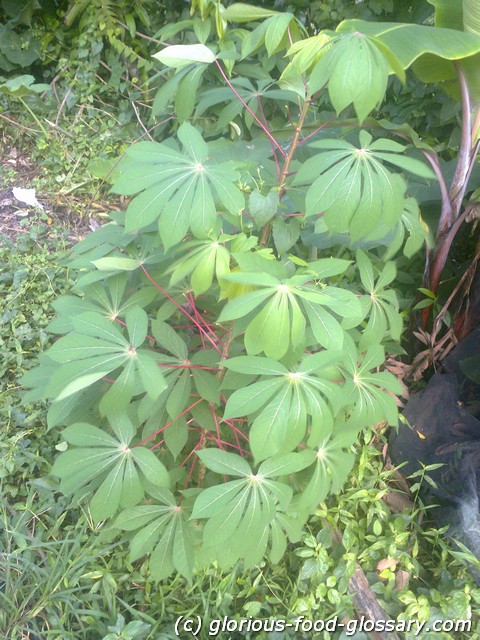Deutsch: Maniokblätter / Español: Hojas de yuca / Português: Folhas de mandioca / Français: Feuilles de manioc / Italiano: Foglie di manioca
Kamoteng Kahoy Leaves in the food context refer to the leaves of the cassava plant, also known as yuca or manioc. Cassava, scientifically named Manihot esculenta, is widely cultivated in tropical and subtropical regions for its starchy tuberous root, which is a major source of carbohydrates. The leaves, often overlooked in some cuisines, are also edible and highly nutritious, rich in protein, vitamins (especially Vitamin A and Vitamin C), and minerals.
Description
Cassava leaves must be properly cooked before consumption to remove potentially harmful cyanogenic glucosides, which can produce cyanide. Once safely prepared, they can be used in a variety of dishes. In many African and Asian countries, cassava leaves are ground into a paste or finely chopped and cooked as a green vegetable in stews, soups, and sauces, often combined with other ingredients such as meat, fish, or coconut milk to enhance their flavor.
Application Areas
Kamoteng Kahoy Leaves are utilized in various culinary practices, including:
- Stews and Soups: Cassava leaves are a key ingredient in many traditional stews and soups, providing a rich, slightly bitter flavor and a hearty texture.
- Side Dishes: Cooked cassava leaves can be served as a nutritious side dish, often seasoned with garlic, chili, and other spices.
- Health Foods: Due to their high nutritional content, cassava leaves are considered a beneficial addition to diets, especially in regions where access to a variety of vegetables may be limited.
Well-Known Examples
Some well-known dishes that feature Kamoteng Kahoy Leaves include:
- Pondu: A popular dish in Central Africa, particularly in the Congo, where cassava leaves are cooked into a thick, savory stew often with palm oil and sometimes meat or fish.
- Saka Madesu: Another Central African dish, combining cassava leaves with beans, often served with fufu or rice.
- Cassava Leaf Stew: Found in various West African cuisines, this stew includes ground cassava leaves, meat (such as chicken, beef, or fish), and often coconut milk or peanut butter.
Recipes
A basic recipe for preparing cassava leaf stew involves:
-
Ingredients:
-
Preparation:
- In a pot, heat a little oil and sauté the onion, garlic, and hot pepper until soft.
- Add the meat or fish and cook until browned.
- Add the cassava leaves and enough water or stock to cover the ingredients. Simmer until the leaves are tender and the meat is cooked through, about 30 to 60 minutes, depending on the tenderness of the leaves.
- Stir in coconut milk or peanut butter, season with salt and pepper, and cook for an additional 10-15 minutes.
- Serve hot with rice or fufu.
Treatment and Risks
It's crucial to cook cassava leaves thoroughly to Break down the cyanogenic compounds. Consuming undercooked cassava leaves can lead to cyanide poisoning, though this risk is minimized by proper preparation and cooking.
Similar Terms or Synonyms
- Cassava Leaves
- Yuca Leaves
Summary
Kamoteng Kahoy Leaves (cassava leaves) are a nutritious and versatile ingredient in many traditional dishes across Africa and Asia. When properly cooked, they offer a rich source of vitamins, minerals, and protein, making them a valuable component of the diet in many parts of the world where cassava is a staple crop.
--
Kamoteng Kahoy is the Filipino word for Cassava. In the Philippines , it is not only the roots of the plant can be sued as food. Some families are already using now the Cassava Leaves to prepare a dish.

Related Articles to the term 'Kamoteng Kahoy Leaves' | |
| 'Vegetables' | ■■■■■■■■■■ |
| Vegetables are edible plants or parts of plants that are consumed as part of a meal, primarily for their . . . Read More | |
| 'Potato' | ■■■■■■■■■ |
| The potato is a starchy, tuberous crop from the perennial Solanum tuberosum of the Nightshade family. . . . Read More | |
| 'Dahon ng Gabi' | ■■■■■■■■■ |
| Dahon ng Gabi in the food context refers to the leaves of the taro plant (Colocasia esculenta), commonly . . . Read More | |
| 'Tapioca' | ■■■■■■■■ |
| Indian: Kolli, Kappa, Marichini, Poolakizhaghu Tapioca is a starchy substance extracted from the roots . . . Read More | |
| 'Inflorescence' | ■■■■■■■■ |
| Inflorescence in the food context refers to the arrangement or cluster of flowers on a plant that is . . . Read More | |
| 'Mogo' | ■■■■■■■ |
| Mogo refers cassava or root potato which is a staple food of Uganda. . . . . . . Read More | |
| 'Milk' at fitness-and-health-glossary.com | ■■■■■■■ |
| Milk is a Nutrient-rich liquid food produced by the mammary glands of mammals. In the fitness context, . . . Read More | |
| 'Sesame' | ■■■■■■■ |
| Sesame is a flowering plant in the genus Sesamum. Numerous wild relatives occur in Africa and a smaller . . . Read More | |
| 'Spinach' | ■■■■■■■ |
| Indian: Cheera Spinach (Spinacia oleracea) is an edible flowering plant in the family of Amaranthaceae. . . . Read More | |
| 'Liver' | ■■■■■■■ |
| Liver: The liver is a vital organ present in vertebrates and some other animals. It has a wide range . . . Read More | |
